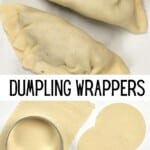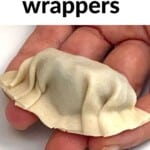This post may contain affiliate links. Please read our disclosure policy.
How to make dumpling wrappers (aka dumpling skins) using just 3 ingredients and a simple process. This versatile vegan dough is perfect for use as dumplings, pierogi, wonton, and gyoza wrappers and is egg-free and freezer-friendly!
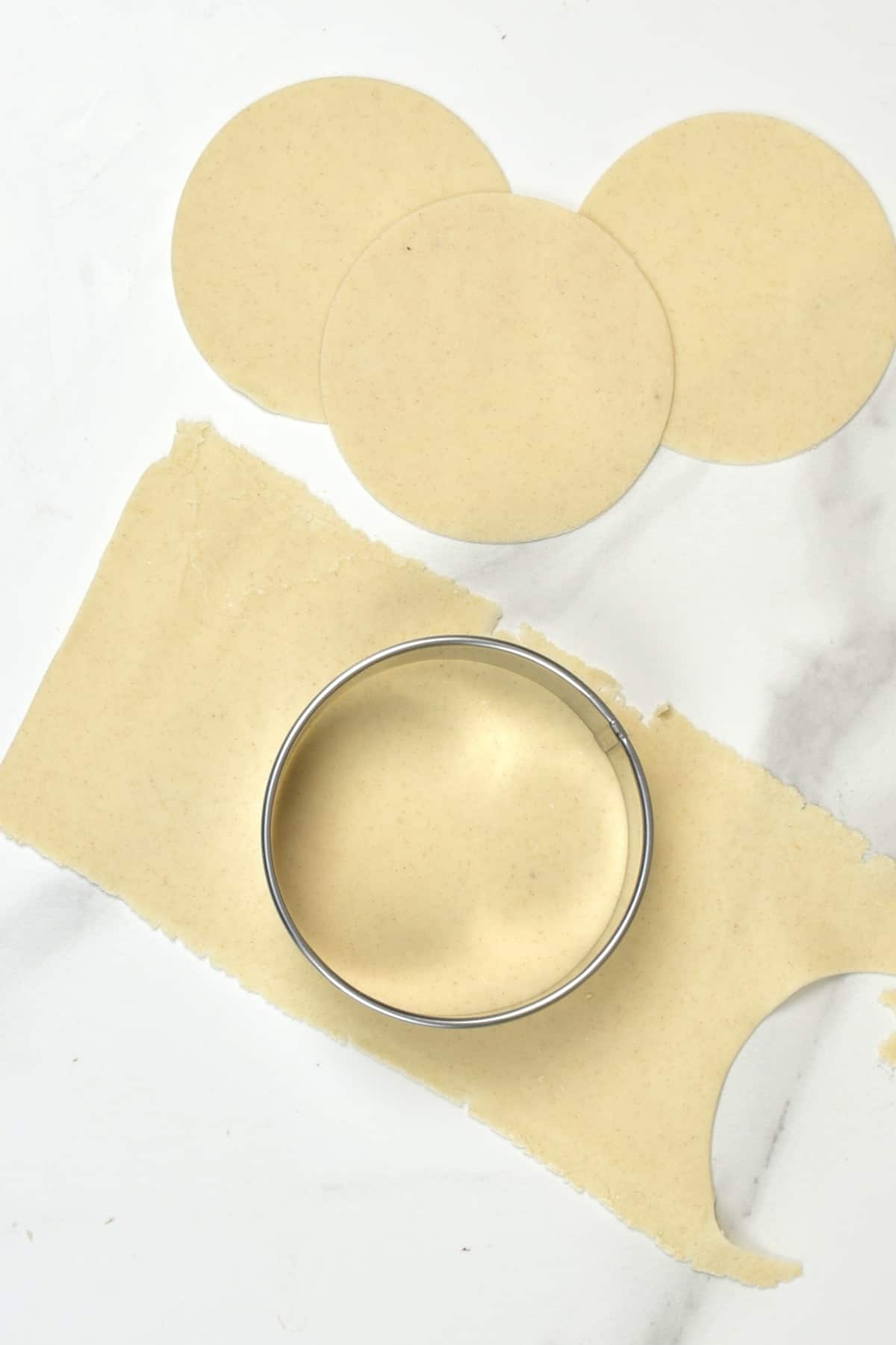
If you’re looking for an all-purpose homemade dumpling dough ready to use for all sorts of stuffed creations, then these dumpling wrappers are for you and your dumplings (and dumpling soup!), potstickers, wontons, gyoza. You certainly won’t run out of ideas any time soon.
I love to make things from scratch, and DIYs have become my go-to for a couple of years now. From homemade butter, cream cheese, lentil or chickpea flour, to avocado oil, and now to these dumpling/gyoza wrappers.
While there are many types of dumplings and wrappers in Asian cuisine, luckily, a few share the same wheat-based dumpling dough. While it’s possible to buy store-bought dumpling wrappers, the fact is, it’s not always that easy if you live in an area without many Asian stores.
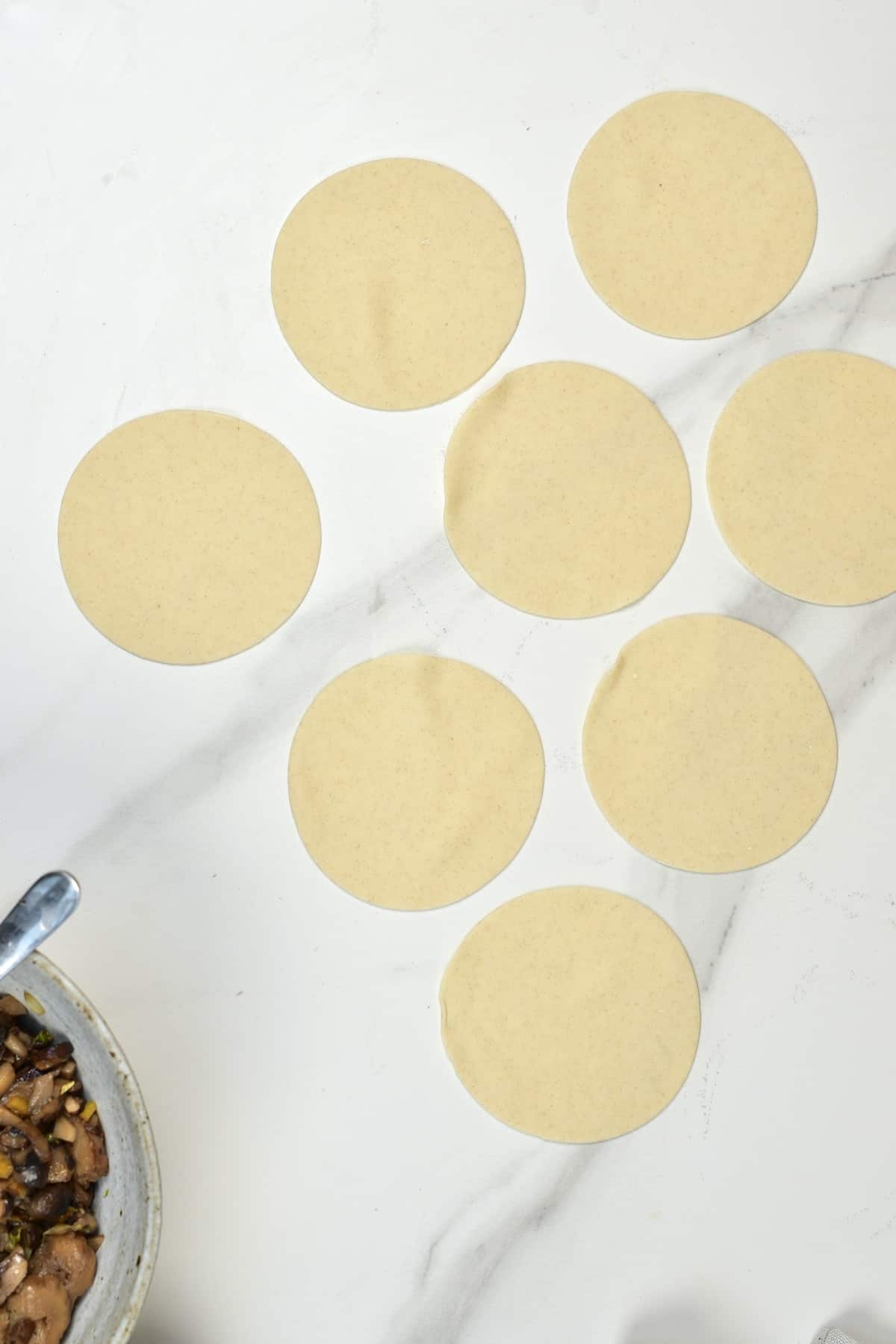
This homemade dumpling dough recipe is also softer and easier to work with and shape (perfect for beginner dumpling makers like myself!) than storebought alternatives. You can also easily adapt the size, shape, and thickness of the dough as needed.
For those that don’t count water and salt as ingredients within recipes, this dumpling dough is just ONE ingredient: flour.
Want to save this recipe?
The Ingredients
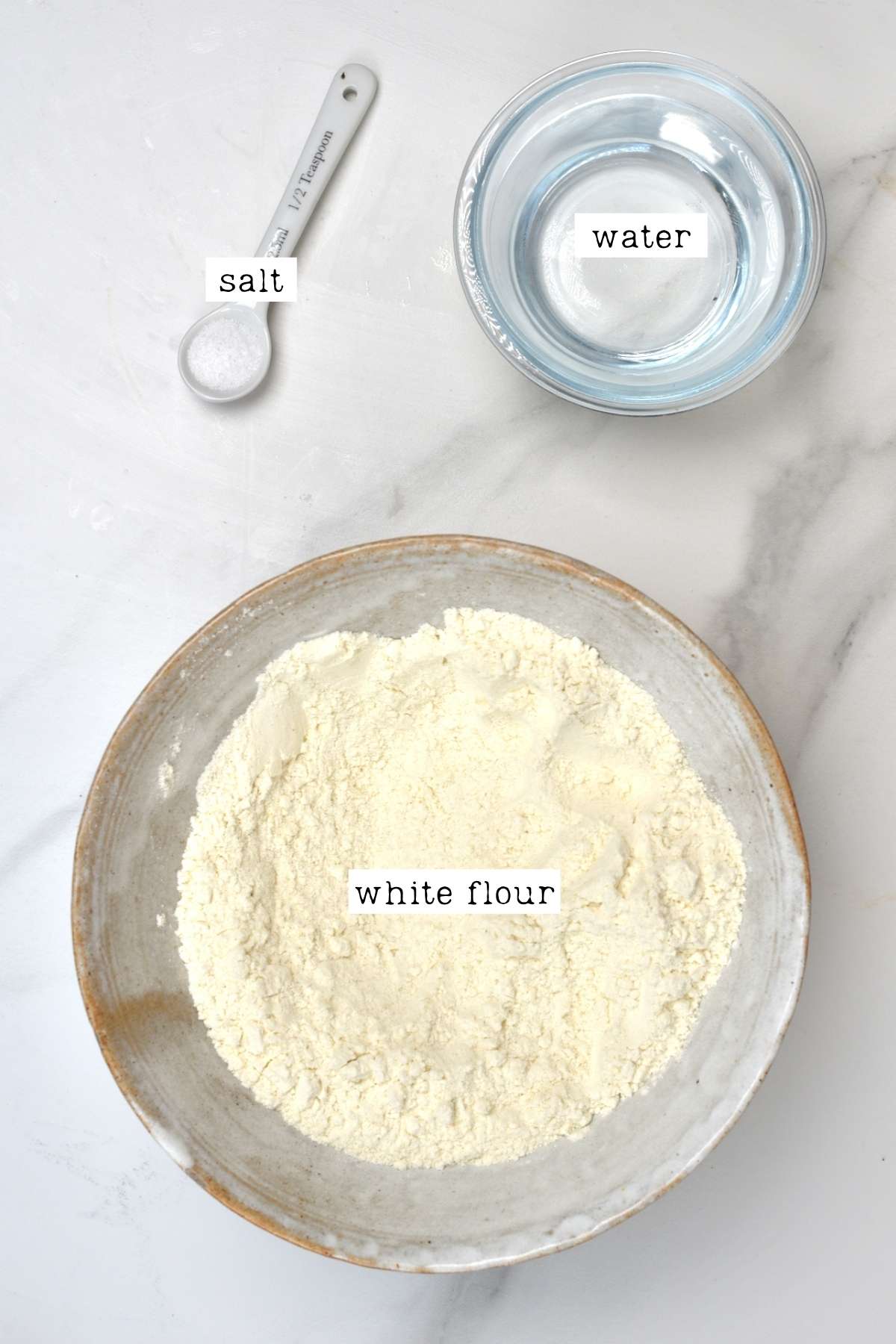
- All-purpose flour: look for flour with a protein content of around 10-11g per 100g. This will produce homemade dumpling wrappers that are tender with a slight chew. Higher protein content can cause tougher, chewier wrappers.
- Warm water: should be around 115ºF/45ºC. This is very important to create a soft and pliable dough yet still retains some elasticity for a tender, slightly chewy dumpling.
- Salt: this adds flavor but also helps to yield a slightly more resilient dough.
- Cornstarch: use cornstarch for dusting the wrappers – all-purpose flour won’t work well as it is absorbed into the wrappers. Tapioca flour would also work.
How To Make Dumpling Wrappers
This dumpling/ gyoza wrapper recipe is simple and requires just two steps – making the dough, then rolling and shaping it! Based on the rolled dough’s size and thickness, you can have vegan wonton wrappers, potsticker wrappers, gyoza wrappers, etc.
Step 1: Prepare the dumpling dough
In a large bowl, mix the flour, salt, and water with a spatula, chopsticks, or your hands, until you form a rough dough. Then transfer it onto a working surface and knead for a couple of minutes into a slightly smoother dough. The dumpling dough should be slightly tacky without being sticky.
The flour you use and the humidity/temperature of where you live can all affect how absorbent the flour is and the amount of water you’ll need, so add a little extra flour or water, if needed, just one tsp at a time until it’s right.
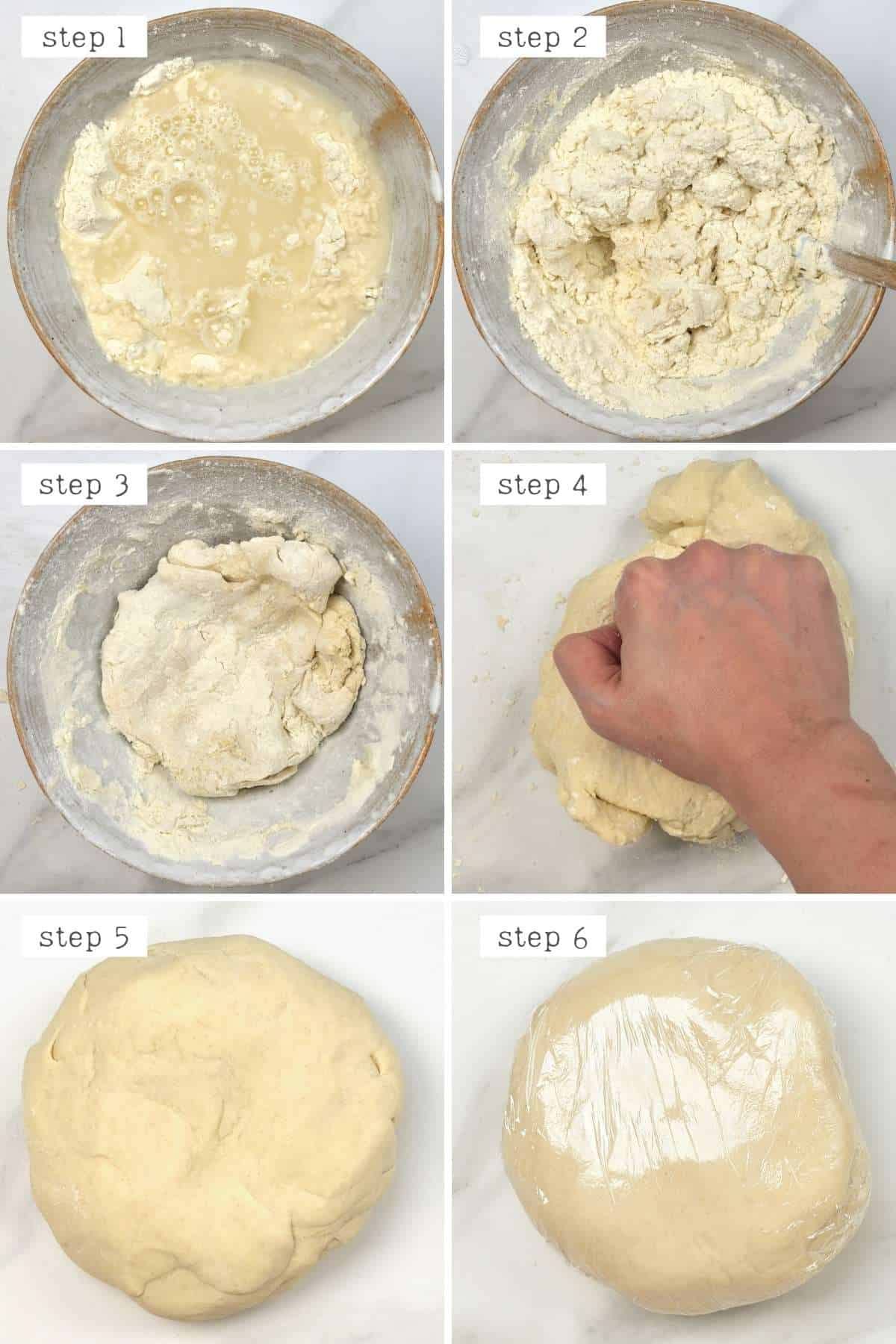
Then, wrap the dough in plastic wrap and allow it to rest for 1 hour in the refrigerator. This time will allow the gluten to develop for a softer, more supple dough that’s easier to roll out and shape. If you’re using flour that contains higher levels of protein/gluten, then a slightly longer rest time is recommended.
Stand mixer directions: Add the flour, salt, and water to the bowl and mix at low speed with the dough hook attachment. Once all the water has been incorporated into the flour, increase the speed to medium-low. Continue mixing for about 2 minutes, until a dough forms and all the loose flour has been gathered into the dough. Turn off the stand mixer and transfer the dough onto a surface. Knead it by hand a few times, then shape it into a ball. Place the dough ball back into the mixing bowl and cover it with a damp towel or a silicone lid. Let it rest for 1 hour.
Step 2: Roll out the dough
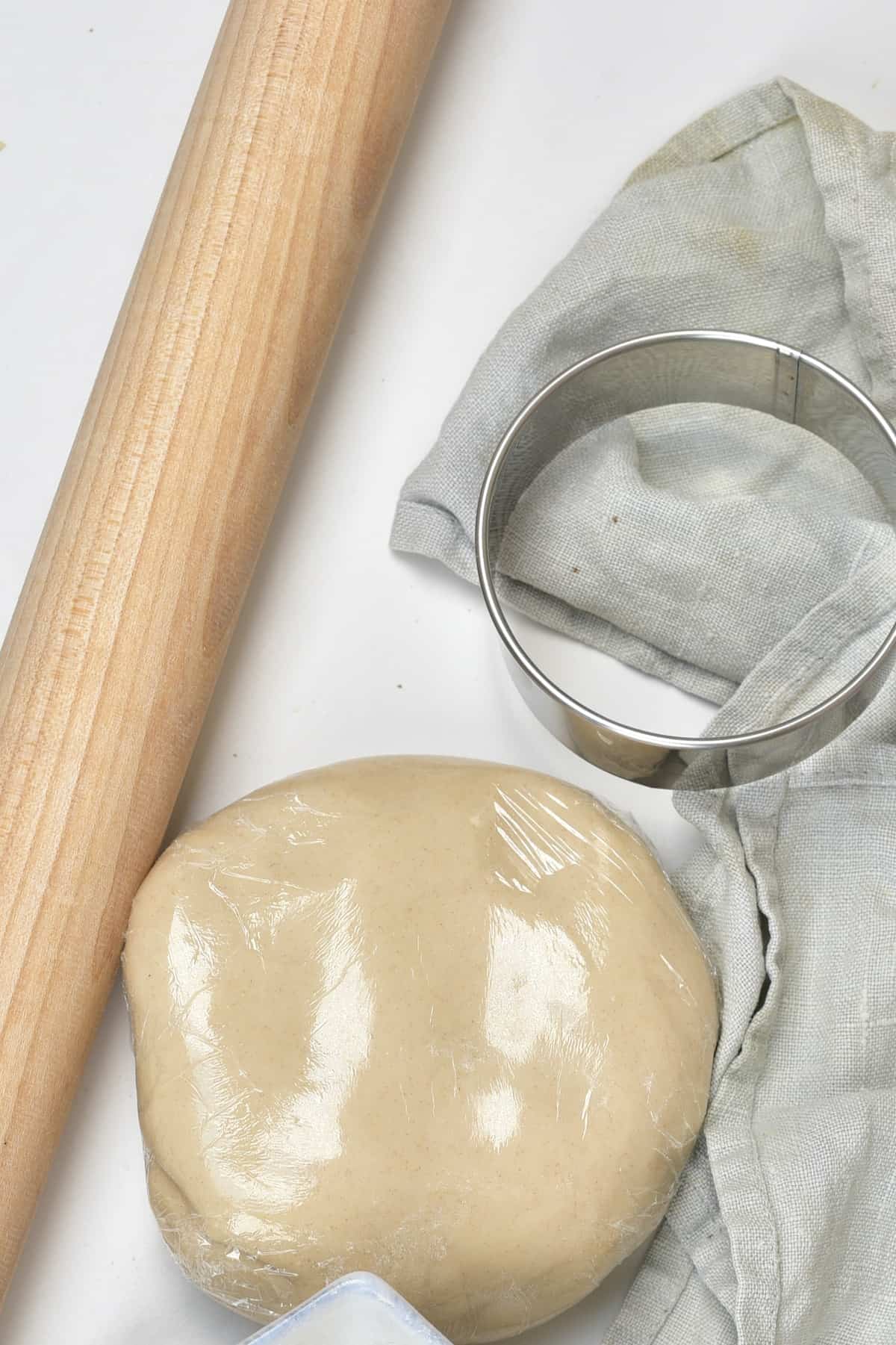
While the dough rests, gather the tools you’ll need: a rolling pin, a kitchen towel, and a cutter – you can use a cookie cutter, the rim of a wine glass, a small bowl, or something similar based on the size of the dumpling wrappers that you want.
When the dough is rested, cut away a section of the dough (I used about 1/3 of it). Make sure to re-wrap the unused dough and place it back in the fridge to stop it from drying out.
Now it’s time to shape the dumpling wrappers. There are several ways to do this, including rolling out dough sheets and cutting out the shapes, weighing and individually rolling each wrapper, or the traditional Chinese/Japanese method, which relies on skill to hand-roll and shape each piece. As I’m a beginner, I decided to use method one, which is the easiest.
For Square Wrappers
You may need squares for things like vegan wonton wrappers, etc. To cut out the squares is super simple.
Roll out the sheet to roughly 6.5 inches (16.5 cm) wide, cutting off the uneven edges. Then use a sharp knife or a pizza cutter to cut squares around 3×3 inches (7.5×7.5 cm) in size.
Gather the scraps to re-roll, though it may be easiest to do this with all the scraps after rolling and cutting out from all the dough portions. Make sure the scraps are wrapped up if you aren’t using them immediately.
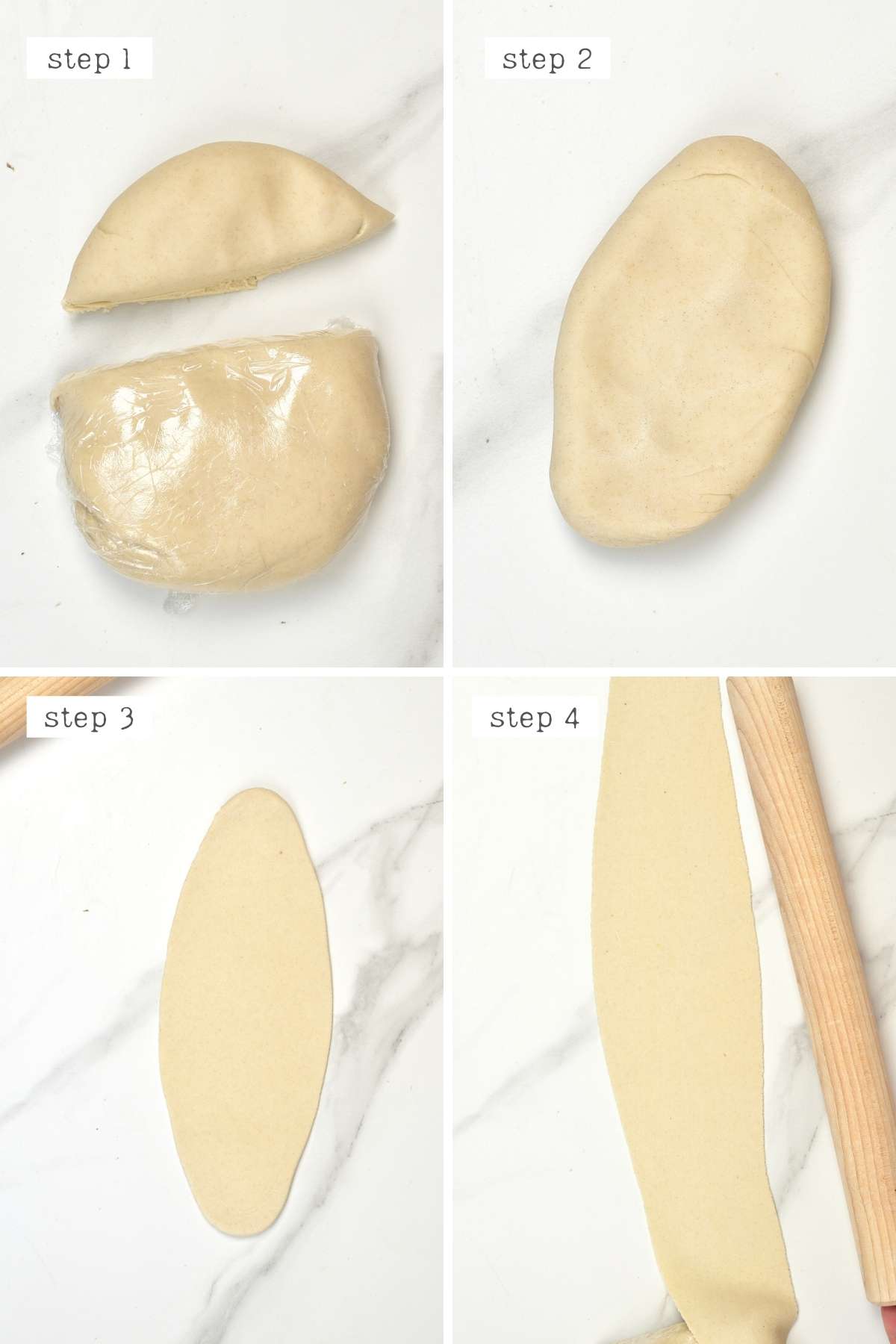
For Round Wrappers
Using a rolling pin, roll the dough as thin as possible. Aim for 2mm for general dumpling/wonton/potsticker wrappers and 1mm for gyoza wrappers. You should be able to see your fingers through the dough. If you have a pasta machine, you can use it to help roll out the dough.
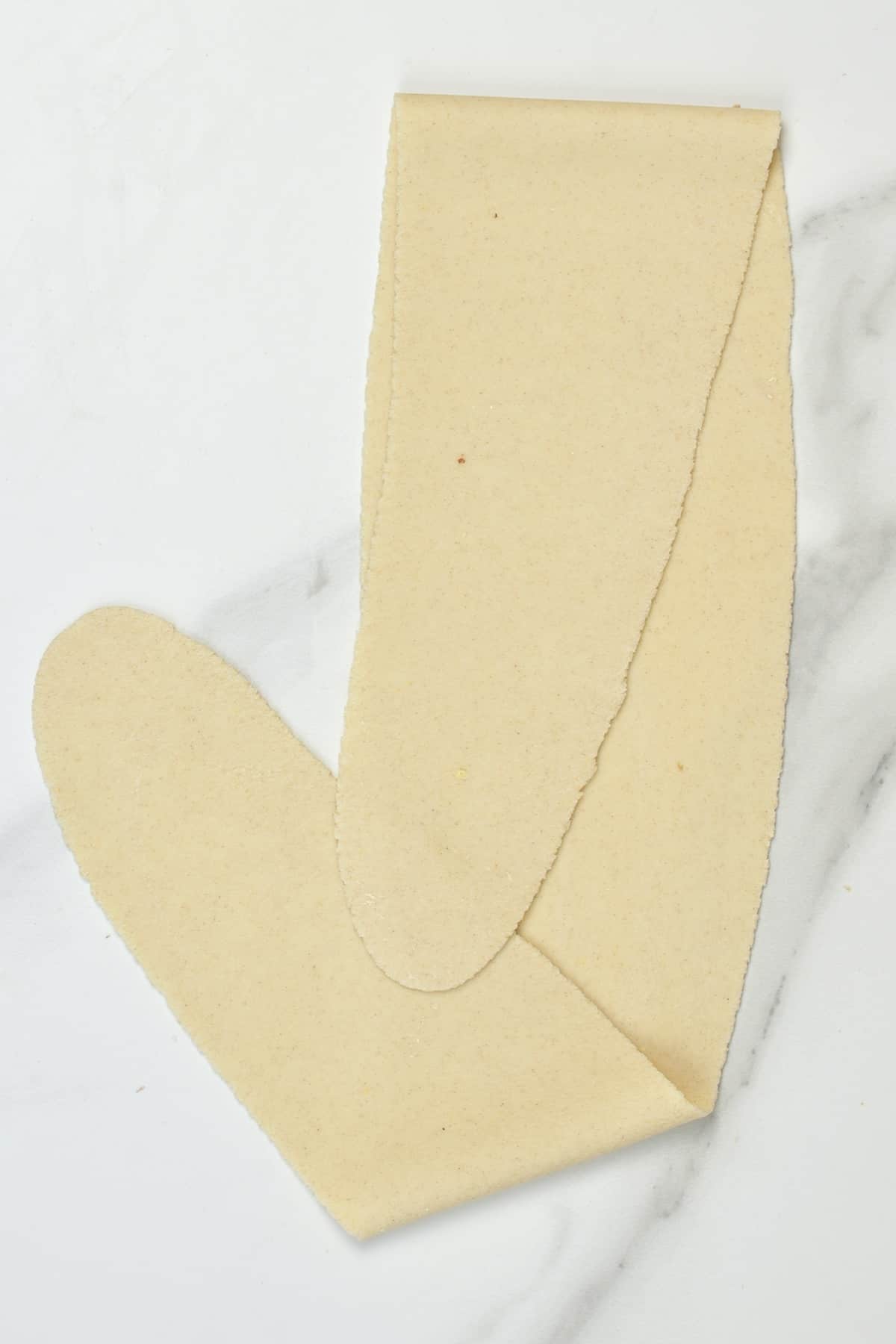
Then, using your cutter tool of choice, cut out the wrappers. If you plan on stacking the wrappers, make sure to dust each one with cornstarch liberally so they don’t stick together.
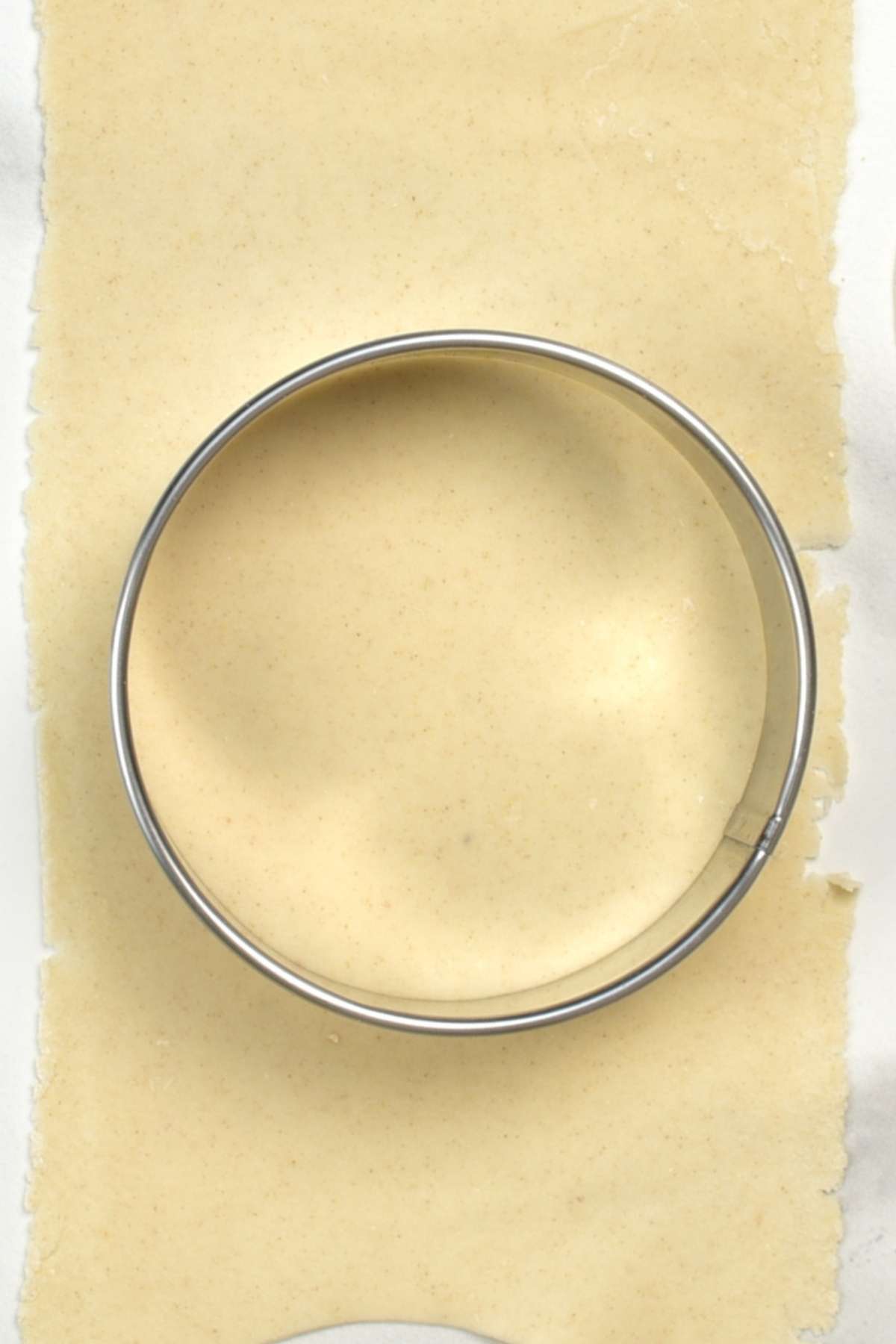
To Measure and Roll
If you’re brave enough to take on the measuring method, then it’s best to make sure that the wrappers are even in size by weighing the dough. As a general rule:
- 9-11 g works well for smaller, thinner wrappers like gyoza.
- 12-13 g is perfect for a medium-sized dumpling.
- 14-15 g will work for larger ‘potsticker’ style dumplings.
However, feel free to experiment to see what size (and weight) you prefer for your homemade dumpling wrappers. Most varieties aim for a size of about 3-4 inches (7.6-10cm) in diameter. With gyoza, try to aim for 1mm thickness; with other dumplings, 2mm should be fine.
The dumpling wrappers dry out fairly quickly, so place any rolled wrappers under a kitchen towel no matter which method above you use. If possible, get your household joining in – one person to cut the dumpling wrappers, the next to fill and pleat them. Working in small batches is best to avoid them drying out.
They’re now ready to fill and pleat – like these mushroom dumplings. You can also fill them with other veggies, shrimp, chicken, pork, kimchi, etc.
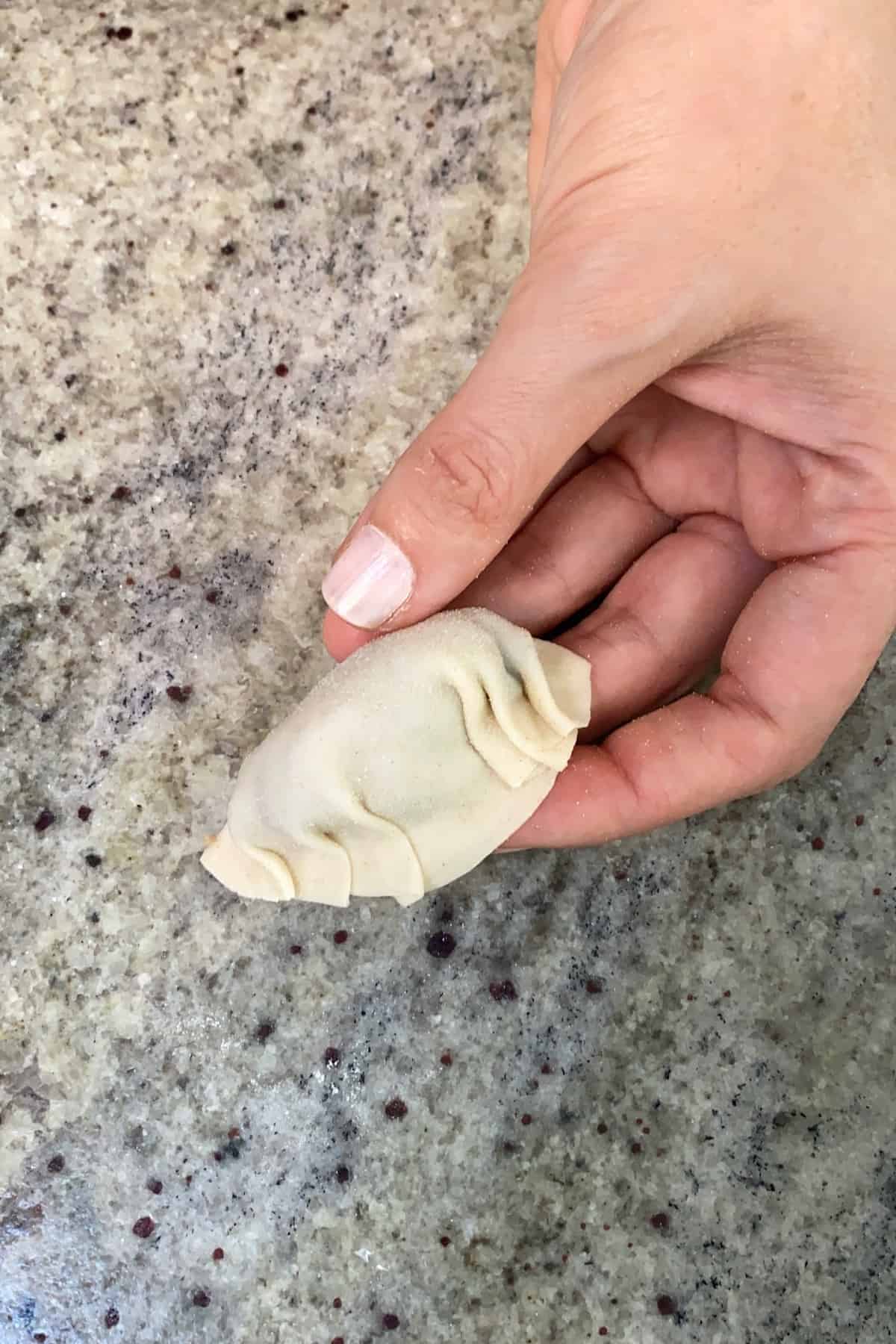
How To Store Dumpling Wrappers
To store: dust each wrapper well with starch and create a stack (or stacks). Wrap the stack tightly in plastic wrap and then place that in an airtight bag, squeeze out the excess air, and store it in the fridge for 1-2 days. They may last up to 3, but it’s a risk as they will begin to dry out and can turn a grey-ish color too.
To freeze: starch and wrap the dumpling/gyoza wrappers as mentioned above then freeze for up to 1 month. To thaw the wrappers, defrost them, covered, in the fridge or on the kitchen counter, and then use them as usual. Alternatively, you can prepare your filled dumplings and freeze them. You can then cook them from frozen!
Make sure to use water to seal any dumpling wrappers that have been stored as the starch will inhibit its’ ability to seal.
Top Tip: You can alternatively cut out bits of parchment paper to lay in between the gyoza wrappers to avoid sticking. That way, they are easy to remove from the freezer based on how many are needed.
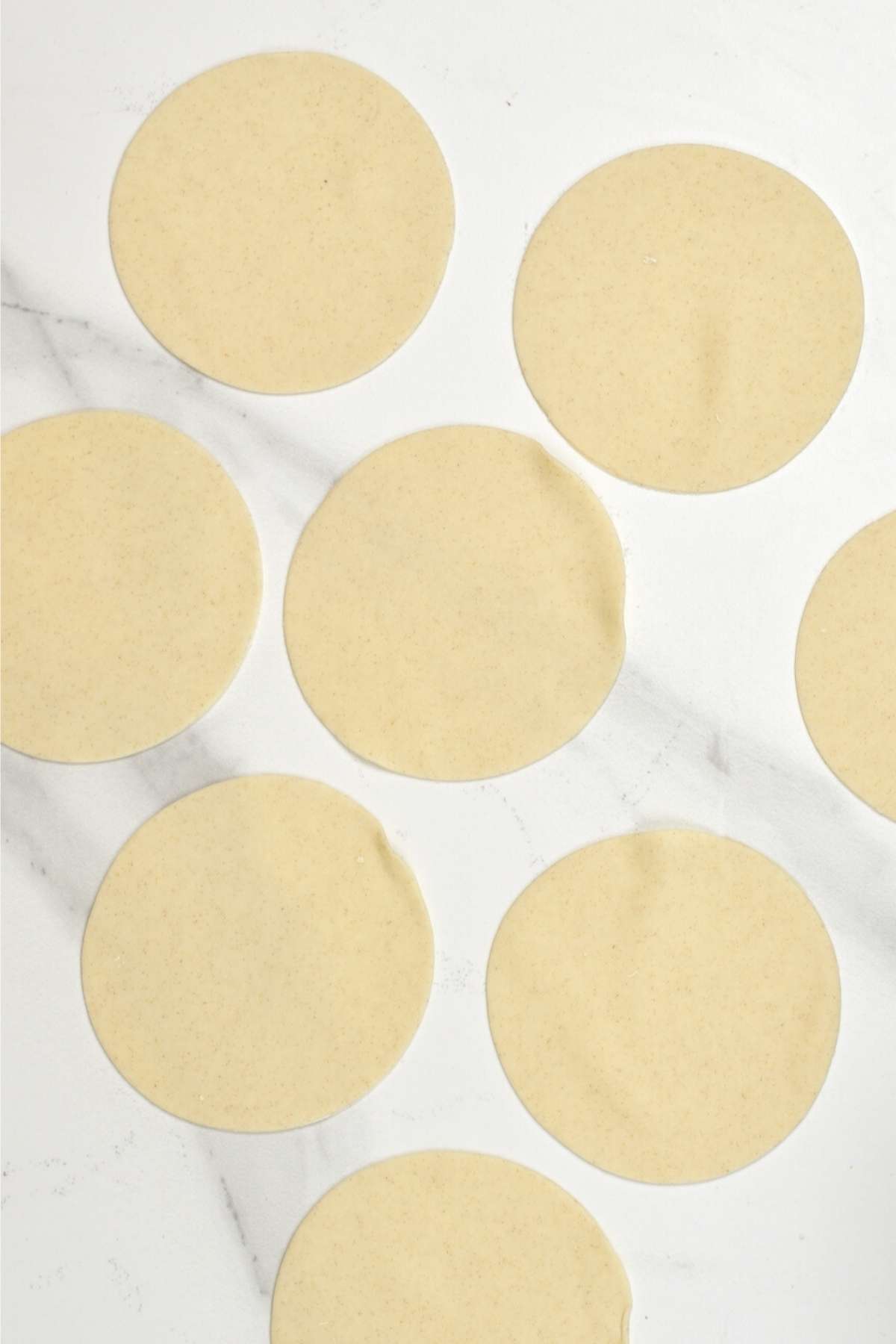
FAQs
In general, the ratio is:
2 cups/250g all-purpose flour to
1/2 Cup/125-130ml water.
In this recipe, I’m using 3 cups flour to 3/4 cup water. Though be aware that using cup size for measuring can be less accurate. Instead, use the weight/ml option for the most accurate results.
After doing the initial kneading, you could tightly wrap and rest the dough overnight in the fridge (rather than for 1 hour). However, be careful as the dough will soften and lose elasticity the longer it rests, so this option is best for higher-protein/gluten flour.
The prepared wrappers are also fine to use for up to 2 days when stored correctly (method above).
Yes, you can. I suggest doing it by hand the first couple of times to get used to feeling when the dough is right and when it needs a little extra water/flour. However, using a stand mixer is a way to make this process even simpler.
Just add the ingredients to your mixer bowl and mix on low with a dough hook. Once the majority of flour is incorporated into the dough, you can increase the speed to medium-low for a couple of minutes into a rough dough.
Knead the dough with your hands just a few times to form a ball before resting it.
Other Recipe Tips
- For softer dumpling wrappers: Replace 1/4 of the flour with cornstarch using warm water. This will yield softer, more tender wrappers that are slightly shiny when cooked.
- It’s good to make the outer edges of the dumpling wrappers thinner. If you thin the outer edge to half its thickness, then the dough will be even throughout when you pleat the dumplings. Without thinning the edges, the pleated part of the dumpling may be a little doughy. I don’t always do this, but it’s worth pointing out.
- The traditional rolling method: I haven’t included this on the blog simply because I don’t feel confident enough in my skills to do this properly (yet). This method requires rolling the dough with one hand while the other constantly rotates the dough.
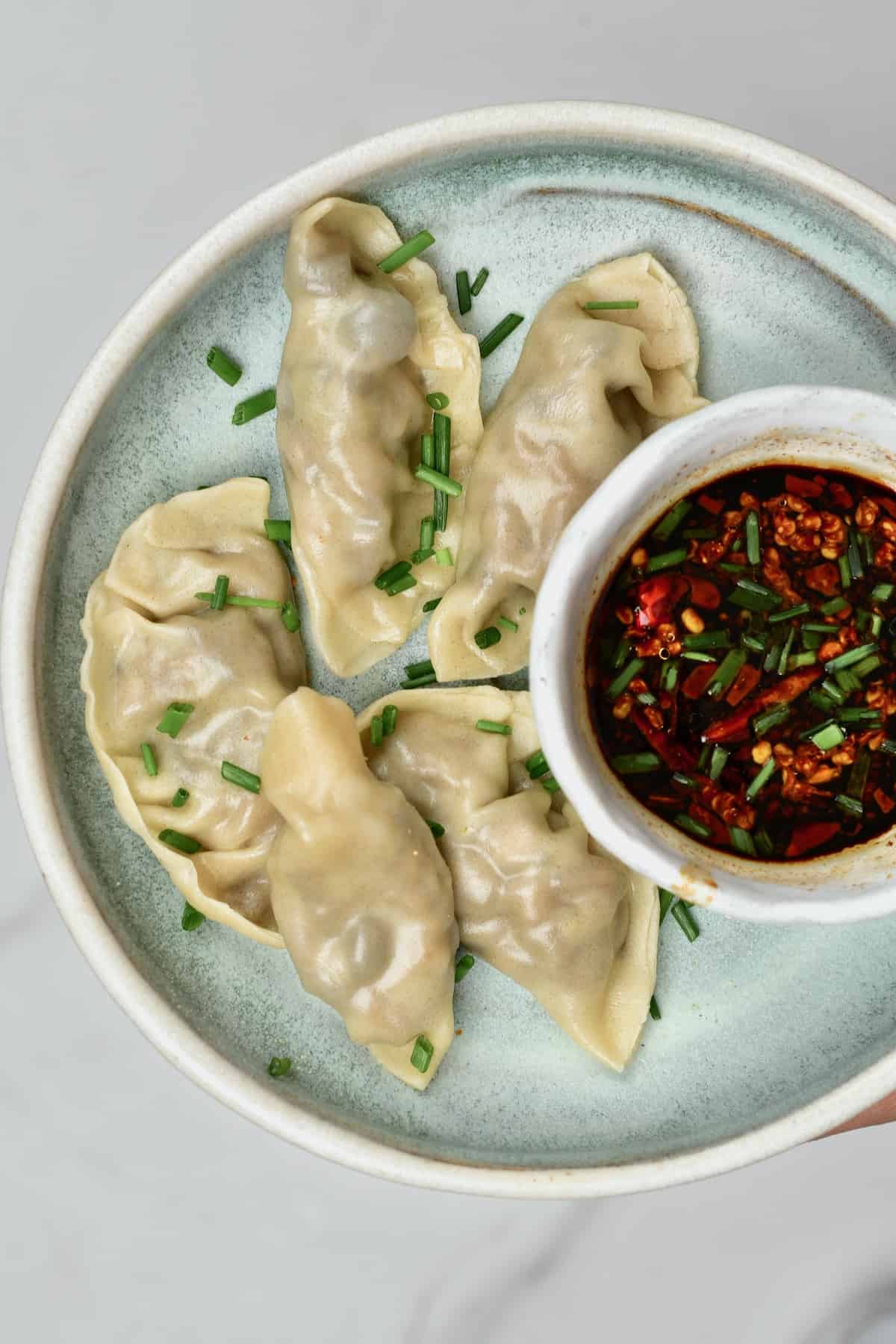
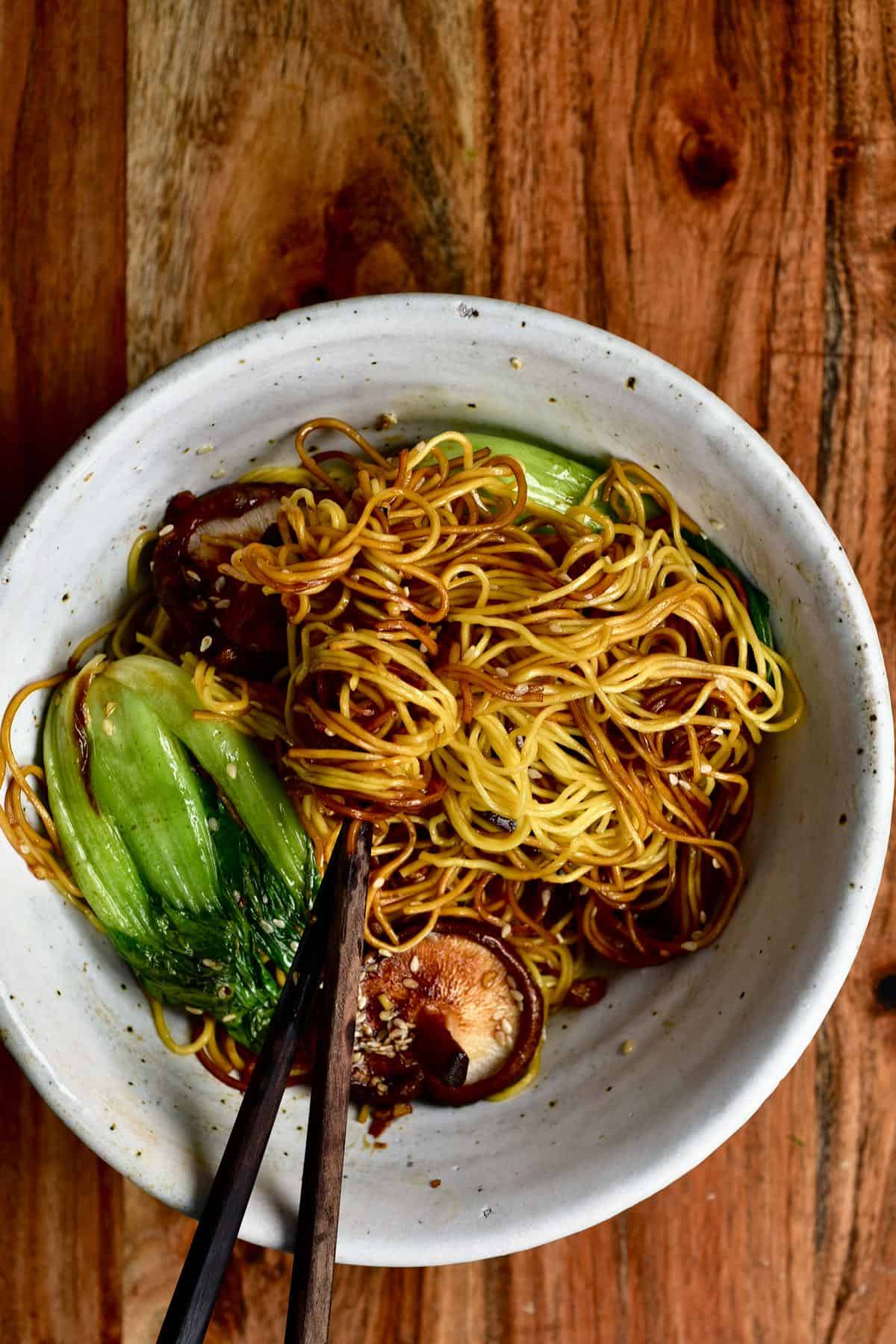

Related DIYs/Recipes
- Steamed Mushroom Dumplings (Potstickers)
- Simple Dumpling Dipping Sauce
- Simple Vegetable Lo Mein (Chili Garlic Noodles)
- Simple Homemade Chili Sauce (Red Chilli Sauce)
- How To Make Garlic Paste (Garlic Puree)
- How to Make Chili Oil
- Crispy Rice Paper Dumplings
If you try this dumpling wrappers recipe, I’d love to hear your thoughts/questions below. Also, I’d appreciate a recipe card rating below, and tag me in your recipe recreations on Instagram @Alphafoodie!
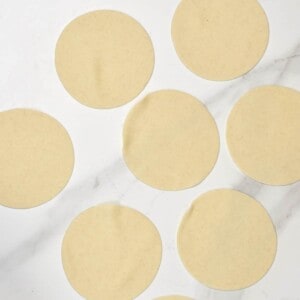
How To Make Dumpling wrappers
Ingredients
- 11 oz white all-purpose flour look for 10-11% protein content
- 2/3 cup warm water at around 115ºF/45ºC
- 1/2 tsp salt
- cornstarch for dusting
Instructions
Step 1: Prepare the dumpling dough
By hand
- In a large bowl, mix the flour, salt, and water with a spatula, chopsticks, or your hands, until you form a rough dough. Then transfer it onto a working surface and knead for a couple of minutes into a slightly smoother dough. The dumpling dough should be slightly tacky without being sticky.The flour you use and the humidity/temperature of where you live can all affect how absorbent the flour is and the amount of water you'll need, so add a little extra flour or water, if needed, just one tsp at a time until it's right.
- Wrap the dough in plastic wrap and allow it to rest for 1 hour in the refrigerator. This time will allow the gluten to develop for a softer, more supple dough that's easier to roll out and shape. If you're using flour that contains higher levels of protein/gluten, then a slightly longer rest time is recommended.
With a stand mixer
- Add the flour, salt, and water to the bowl and mix at low speed with the dough hook attachment. Once all the water has been incorporated into the flour, increase the speed to medium-low. Continue mixing for about 2 minutes, until a dough forms and all the loose flour has been gathered into the dough. Turn off the stand mixer and transfer the dough onto a surface. Knead it by hand a few times, then shape it into a ball. Place the dough ball back into the mixing bowl and cover it with a damp towel or a silicone lid. Let it rest for 1 hour.
Step 2: Roll out the dough
- While the dough rests, gather the tools you'll need: a rolling pin, a kitchen towel, and a cutter – you can use a cookie cutter, the rim of a wine glass, a small bowl, or something similar based on the size of the dumpling wrappers that you want.
- When the dough is rested, cut away a section of the dough (I used about 1/3 of it). Make sure to re-wrap the un-used dough and place it back in the fridge to stop it from drying out.Time to shape the dumpling wrappers. There are several ways to do this, including rolling out dough sheets and cutting out the shapes, weighing and individually rolling each wrapper, or the traditional Chinese/Japanese method, which relies on skill to hand-roll and shape each piece. As I'm a beginner, I decided to use method one, which is the easiest.
For Square Wrappers
- Roll out the sheet to roughly 6.5 inches (16.5 cm) wide, cutting off the uneven edges. Then use a sharp knife or a pizza cutter to cut squares around 3×3 inches (7.5×7.5 cm) in size.Gather the scraps to re-roll, though it may be easiest to do this with all the scraps after rolling and cutting out from all the dough portions. Make sure the scraps are wrapped up if you aren't using them immediately.The dumpling wrappers dry out fairly quickly, so place any rolled wrappers under a kitchen towel no matter which method above that you use. If possible, get your household joining in – one person to cut the dumpling wrappers, the next to fill and pleat/seal them. Working in small batches is best to avoid them drying out.
For Round Wrappers
- Using a rolling pin, roll the dough as thin as possible. Aim for 2mm for general dumpling/wonton/ potsticker wrappers and 1mm for gyoza wrappers. You should be able to see your fingers through the dough. If you have a pasta machine, you can use it to help roll out the dough.Then, using your cutter tool of choice, cut out the wrappers. If you plan on stacking the wrappers, make sure to dust each one with cornstarch liberally so they don't stick together.
To Measure and Roll
- If you're brave enough to take on the measuring method, then it's best to make sure that the wrappers are even in size by weighing the dough. As a general rule:9-11g works well for smaller, thinner wrappers like gyoza wrappers.12-13g is perfect for a medium-sized dumpling.14-15g will work for larger 'potsticker' style dumplings.However, feel free to experiment to see what size (and weight) you prefer for your homemade dumpling wrappers. Most varieties aim for a size of about 3-4 inches (7.6-10cm) in diameter. With gyoza, try to aim for 1mm thickness; with other dumplings, 2mm should be fine.
- They're now ready to fill and pleat – like these mushroom dumplings. You can also fill them with other veggies, shrimp, chicken, pork, kimchi, etc.
How To Store Dumpling Wrappers
- To store: dust each wrapper well with starch and create a stack (or stacks). Wrap the stack tightly in plastic wrap and then place that in an airtight bag, squeeze out the excess air, and store it in the fridge for 1-2 days. They may last up to 3, but it's a risk as they will begin to dry out and can turn a grey-ish color too.To freeze: starch and wrap the dumpling/gyoza wrappers as mentioned above then freeze for 1 month. To thaw the wrappers, defrost them, covered, in the fridge or on the kitchen counter, and then use as usual. Alternatively, you can prepare your filled dumplings and freeze them. You can then cook them from frozen!Make sure to use water to seal any dumpling wrappers that have been stored as the starch will inhibit its' ability to seal.
Notes
- For softer dumpling wrappers: replace 1/4 of the flour with cornstarch using warm water. This will yield softer, more tender wrappers that are slightly shiny when cooked.
- It’s good to make the outer edges of the dumpling wrappers thinner. If you thin the outer edge to half its thickness, then the dough will be even throughout when you pleat the dumplings. Without thinning the edges, the pleated part of the dumpling may be a little doughy. I don’t always do this, but it’s worth pointing out.
- The traditional rolling method: I haven’t included this on the blog simply because I don’t feel confident enough in my skills to do this properly (yet). This method requires rolling the dough with one hand while the other constantly rotates the dough.
- Top Tip: You can alternatively cut out bits of parchment paper to lay in between the wrappers to avoid sticking. That way, they are easy to remove the freezer based on how many are needed.
Nutrition
Nutrition information is automatically calculated, so should only be used as an approximation.





